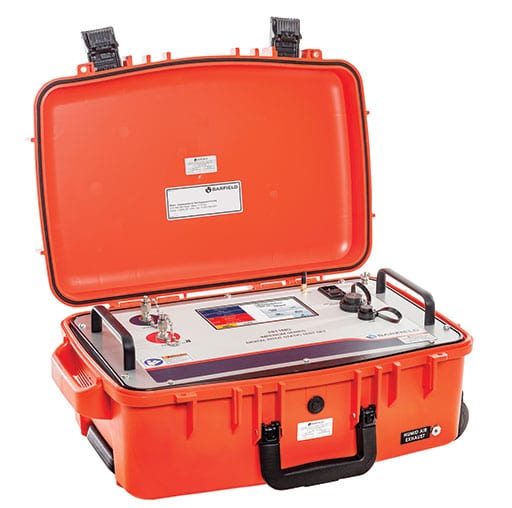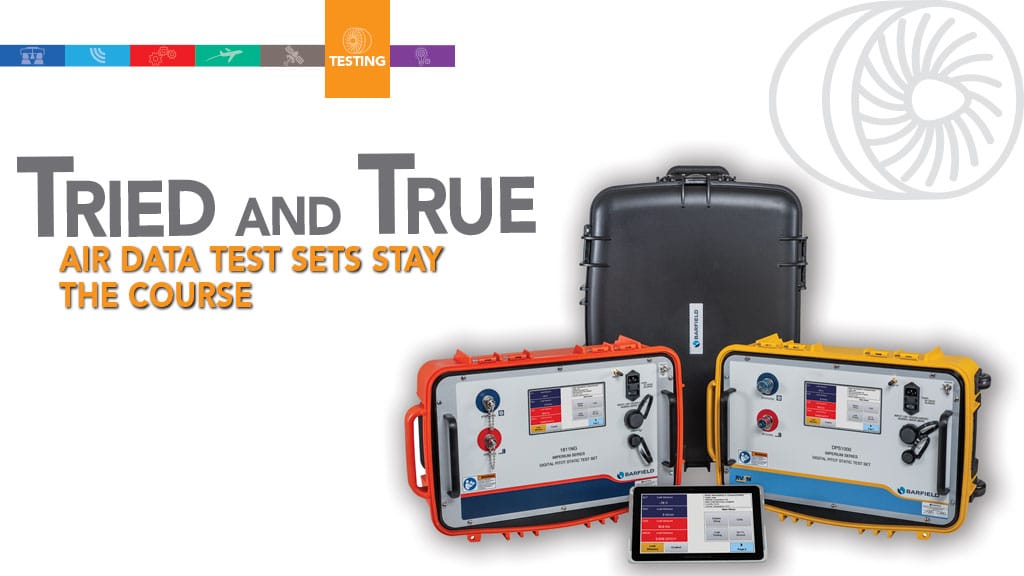Despite the advances in aviation technology, only a little has happened in the world of pitot static systems and their associated test sets. Ian Harbison reports.
In aircraft’s pitot static system provides several critical flight parameters to the crew. It does this via a forward-facing pitot tube and a static port. The pitot tube measures the dynamic pressure of the air entering it, or the difference between the ambient air pressure and the force of the air caused by the aircraft’s forward movement. The static port measures the ambient air pressure and so is located out of the airflow. A pitot static tube combines both functions.
The pressure in the pitot tube can be translated into airspeed, while the static pressure changes with altitude, providing height information and the rate of climb or descent. This can be done by physically moving a needle on analogue instruments or providing a number for digital systems.
Victor Bontorno, director – Distribution & Ground Support Test Equipment, at Barfield in Miami, says his company has more than 40 years of experience in the pitot static business but, while engines and avionics have gone through remarkable progress, the industry still designs around and measures performance in the same old way — there is little essential difference between a Douglas DC-3 and an Airbus A380. The only major change to the status quo was the worldwide introduction, between 1997 and 2005, of Reduced Vertical Separation Minima (RVSM).
Under this regime, from FL290-410, aircraft could fly 1,000ft above or below each other, a halving of the previous requirements, but only if they were suitably equipped. This involved two independent altitude measurement systems; an altitude alerting system; an automatic altitude control system; and a transponder with altitude reporting system that is connected to the altitude measurement systems.
The result, he says, was a huge stimulus to the market and introduced a number of new players who developed new test sets with increased accuracy to match the regulatory demands for periodic checks on the accuracy of the RVSM equipment.
There have been changes in the testing world, however. An Air Data Test Set can also measure manifold pressure and engine pressure ratio (EPR), increasing usefulness. There is also a move to digital, as repair of analogue equipment is becoming increasingly expensive.

Of course, there needs to be a range of test sets for different sectors of the aviation market. For example, the DPS501 NG is Barfield’s latest high accuracy air data management system test set that complies with RVSM requirements. A 10.4in backlit LCD display allows operators to switch between modes while testing without affecting operation while all the data is recorded for storage and later playback.

Operational realties also come into play. The DPS501 NG can be operated remotely, with the operator sitting in the cockpit monitoring the instrument displays instead of having a long cable connection from the test set in the ground. It is also usable with gloves in cold weather conditions — an AOG aircraft diverted for a speed mismatch between the pilots’ displays that needs checking may not be in a warm hangar.
The DPS1000 is another RVSM compliant air data test set but incorporates a wireless tablet communication capability. As well as controlling the unit this way, it means that using secure Wifi Direct, data can be sent to maintenance control, where an engineer can carry out trouble shooting on a difficult problem.
Further flexibility is demonstrated by the less sophisticated 1811NG, designed for general aviation, helicopter, UAV, non-RVSM regional and corporate aircraft, which has additional test functions such as cabin pressure and inlet barrier mode (intake particle separation in helicopters).
Nav-Aids
The link between the air data test set is an adapter consisting of a long hose assembly with covers at the end for pitot tubes and the static ports. Peter Moores, managing director at Montreal-based Nav-Aids, says the company has almost 60 years of experience and is considered one of the leading suppliers — it is a sole source for Barfield, for example.
As the position of the air data system components vary from aircraft to aircraft, each adapter has to be tailor made, involving early cooperation with the OEM on a new aircraft design as it will have to be tested before its first flight. As new variants are introduced, there may be small differences that require a new solution — there are several options for the Boeing 737, for example.
However, he says the OEMs can also get involved. Airbus was unhappy with a design that was inserted into the static port, on the A320 Family as it caused occasional scratching of the surface. An in-house engineering team came up with a solution that involves a bar being screwed into place on the fuselage. The adapter is moved along the bar to position it over the port. Airlines can also have a say, requesting customised kits that allow a quick test to be carried between flights.
Hose is a deceptive description. It is actually composed of a number of snap together sections that can be quickly assembled. They have to withstand considerable pressure during testing and also remain flexible in low temperatures. For the pitot tube, it is relatively easy to produce an adapter that slips over and has an airtight seal. As the static ports are flush with the fuselage skin, suction pads are generally used. Suction pads are also used to support the hose on the side of the fuselage, to avoid weight pressure if it were just to hang down — due to the size of the aircraft and the location of the pitot tubes and static ports, the hose for the Boeing 747-400 is 120ft long.
He agrees that development is slow but points out that the company is now involved with adapters for UAVs, a new market. He also says smart probes for the military have three channels of data, rather than the customary two as they can also measure angle of attack. They are now making a move into commercial aviation.
DMA
Paul Crowhurst is a Director at Evolution Measurement, sales agents for DMA, which is based in Aprilia, just south of Rome in Italy.
He says a design trend in recent years has been to decrease the weight and size of air data test sets. This has been achieved by lighter, smaller pumps, while efficiency and reliability have increased through the use of brushless electric motors. In addition, they can now often run on batteries, mains power or aircraft power. The testing process involves pressurising the system and then changing the pressure to simulate changes in speed and altitude. Exact values are calculated for each parameter and this provides the flight simulation aspect of the process. With increases in processing power, developments in sensor technology and that the data refresh rate is now much higher, providing greater levels of accuracy.
A good example is the MPS43B digital pitot static test kit from DMA. Designed for use on the flight line, it is compact and weighs just 4.5kg. All the important air data functions are displayed simultaneously, which include altitude to 55,000 ft, speed to 550 kts and rate of climb to 6000 ft/min. It is RVSM compliant. As well as a conventional keypad and a multi-coloured touchscreen display, it can be remotely controlled by a handheld control or wireless controlled by a remote touchscreen terminal. There is also an optional Bluetooth control capability for use with tablets or laptops. Up to 30 independent test profiles can be stored, each with 26 test points, as well as 300 profile results. With maintenance in mind, the internal pressure and vacuum pumps run only when required, extending the pump life.
Finally, Bontorno at Barfield says that, given the criticality of air data systems for aircraft safety, especially for RVSM, it is important that the regulatory recertification checks and maintenance and overhaul are carried out properly. That means a return to the OEM or an OEM-approved repair station, as a third party check is simply, at best, confirmation that the performance meets published specifications. What is needed is a true calibration that results not only in the equipment operating at its optimum accuracy and performance levels but also ensures it will maintain that performance until the next check.
